Blog

It’s hard to keep your chin up and be positive when you are going through a rough time. For me, hearing the words, “You have cancer” was shocking. But it had nothing on seeing my hair fall out, having my breasts removed and gaining so much weight that I didn’t recognize my body anymore. Those things, well, they broke my heart.
Cancer changes you. It changed me forever. I didn’t look the same after cancer. And I certainly didn’t feel the same. Now, when I want to remember the girl I was before I got sick, I have to look through pictures. It seems like another life.
Change sucks. It forces us to pivot – even when we don’t want it. Maybe you were diagnosis with illness. Maybe your spouse asked for a divorce. Maybe you lost your job. Whatever the case may be – change, or “trouble” as I call it, forces you to face a new reality, one that takes you out of your comfort zone and tests who you really are.

I had the Trifecta of trouble: I was diagnosis with cancer, quit my job and dumped my long-term boyfriend – all at the same time! I figured that since my whole word had turned upside down because of the cancer, I might as well just take the wrecking ball to it and knock out some other necessary changes I needed to make. Looking back, I realize this wasn’t the smartest move. I probably should have given myself a minute to get healthy first. Hindsight is 20-20, right?
The thing is, I knew that if I didn’t make the changes then, I never would. I had gotten too comfortable, too complacent, in my day-to-day life. I tolerated situations and behaviors that didn’t reflect my true self or core values. By accepting, even participating in them, I was preventing myself from being the woman I wanted to become. I was stopping my own growth. And it wasn’t until I had cancer – and lots of hours alone in the chemo suite – that I was able to reflect on how off track my life had become.
That’s the thing about “trouble.” It is often a catalyst to a better life. Each uncomfortable change is really a chance to transform into a better version of ourselves. It pushes us beyond our expectations. It helps us expand our frame of reference, awareness and attitude. It presents us with unexpected opportunities. Trouble is transformation.
With no job to speak of, I decided to make a list of every publication and website that I loved and I set out pitching those editors. I was also single (and sometimes really sad about it) but I forced myself to have a positive attitude and enjoy dating. And I took the time to focus on my health and tune into my mind-body connection. It wasn’t easy. It was a pretty painful process at times. But I am a much different woman today because I didn’t back down from the challenge. Now, I have an impressive resume. I am engaged to a wonderful man. And I am healthy and happy.
The question is: How are you going to handle your “trouble?” Are going to let it crush your spirit or are you going to kick its ass? Are you going to complain about your tough boss or are you going to see that person as someone who is going to push you to expand your skill set? Are you going to look at your bankruptcy as hard knocks or an opportunity to let go of burdens and responsibilities that weighed you down and have a start fresh? Are you going to get angry or sad about your cancer or will you use it to find the true purpose of your life and to help others. The choice is up to you. I know you can do it!

XO,
Cait
…Hello again! If you got all the way down here, then I’m assuming you liked what you read. Good news! There’s more where that came from – including snippets of Pretty Sick: The Beauty Guide for Women with Cancer and news relevant to us Cancer Cuties. Go visit and (like!) the Pretty Sick Book FB page! https://www.facebook.com/prettysickbook/?ref=aymt_homepage_panel
Pretty Sick is out September 19th, but you can order your copy now! Just click below on the retailer of your choice!
Amazon
Barnes & Noble
IndieBound
iBooks
Blog

There are certain physical changes we all know to expect during cancer treatment – like hair loss and dry skin. But many patients, including myself, are caught off-guard when we start having issues with our nails. It makes sense, of course. Chemotherapy targets and kills all the rapidly dividing cells in our bodies – including the ones that help our nails form and grow.
The good news is that nails are resilient structures and can endure a tremendous amount of trauma. That’s way many people that have chemotherapy won’t lose their nails or won’t show any signs of stress but much of it depends on what type of chemotherapy protocol you have. Studies show that Docetaxel and paclitaxel have a 44% incidence rate for dramatic changes to the nail structure. Changes can include nail loss, discoloration, Beau’s lines (transverse grooves in the nail) and periungual lesions – just to name a few. I had CMF chemotherapy – a relatively “light” protocol – yet my nails still got really weak and began peeling like crazy.
What sets these side effects apart from those of the skin and hair is that they aren’t immediate. Since nails grow at a slow rate, under one millimeter per day, it takes almost two months for the nails that were formed during the days of chemo to grow out long enough to be seen! Because of this, there is nothing you can do to reverse the damage that was done to the nail’s matrix months ago. That said, there are things you can do to keep your nails as healthy – and pretty – as possible.

For my book Pretty Sick: The Beauty Guide For Women with Cancer (that hits stands on Sept. 19!) I interviewed celebrity manicurist Elle Gerstein, who counts Blake Lively and Jennifer Lopez as longtime clients, and Dr. Dana Stern, NYC-based dermatologist and the founder of Dr. Dana: Natural Nail Care System, the first dermatologist-created nail care line. Both nail experts shared advice on how to keep your nails in tip-top shape during treatment. Here’s how:
Keep Your Tips Dry: Water is the harshest thing for our nails. I know this seems crazy, but water is the leading culprit behind weak, peeling, breaking nails. The solution is simple: Wear rubber gloves when doing wet work around the house and leather gloves when going out in the rain or snow.
Break out the Biotin: This water-soluble B vitamin is the only supplement that has studies that back up with efficacy. Nail dermatologist (yes, that’s a real thing) recommend 2.5 milligrams a day. Make sure to take them!
Get Growing: If Biotin doesn’t do the trick there are two FDA-approved prescription topical medications that can transform fragile nails. Genadur (a hydro-soluble lacquer) works by filling in the microscopic gaps within the nail surface to create a physical support to the nail bed. Nuvail (a polyurethane protective solution) creates a flexible sealant over the nail plate protecting it and helping to maintain moisture levels.
Don’t Use Your Tips as Tools: Most of the damage our nails endure is self-inflicted. When we use our fingernails as tools – like as a screw driver or a scraper – we cause them to fray and tear. Being aware of this bad habit will help you correct it – and keep your nails healthier.
Cuticle Oil is Key: Want strong, healthy nails? Cuticle oil – specifically those made from Vitamin E, almond, jojoba and olive oil are super hydrating and keep the nails pliable and prevent delaminating. Applying it on the cuticle twice a day will get the blood flowing and help stimulate cell regeneration and growth.
I hope these tips help! If there is a nail treatment or tip that worked wonders for you during treatment I’d love to hear about it!
XO,
Cait
…Hello again! If you got all the way down here, then I’m assuming you liked what you read. Good news! There’s more where that came from – including snippets of Pretty Sick: The Beauty Guide for Women with Cancer and news relevant to us Cancer Cuties. Go visit and (like!) the Pretty Sick Book FB page! https://www.facebook.com/prettysickbook/?ref=aymt_homepage_panel
Pretty Sick is out September 19th, but you can order your copy now! Just click below on the retailer of your choice!
Amazon
Barnes & Noble
IndieBound
iBooks
Blog
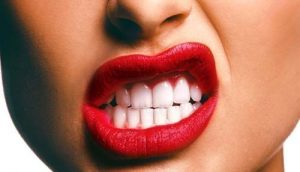
Sink your teeth into this: More than 40% of cancer patients having chemotherapy, and almost every patient undergoing radiation, will experience oral mucositis (mouth sores), xerostomia (dry mouth) and oral thrush.
Now, I know what you are thinking: what’s the big of a deal? The fact is, oral care issues can have serious implications on a patient’s health. Mouth sores, which can get as large as one and a half inches, can become so painful that it causes a patient to stop eating and become malnourished. Dry mouth is problematic because saliva contains enzymes that help break down bacteria, preventing cavities and infections. Oncologists have been known to stop chemotherapy or radiation if a patient has either issue. Trust me when I say, you don’t want to find yourself in this position. There is nothing worse than having to delay treatment by weeks or months because of issues related to your teeth and gums.
Since the stats show that almost half of the cancer community will experience some sort of oral care issue, I’m here to share some tips from my book, Pretty Sick: The Beauty Guide for Women with Cancer, that help prevent or minimize these side effects. They are:
Make a Dentist Appointment STAT!
I know that last thing you want to do is to go see another doctor’s appointment but the sooner you can get to the dentist so he clean your teeth and check out your mouth, the better the chance you stand for avoiding these irritating issues later on.

Brush up on your technique
It’s not rocket science but how you brush your teeth (and gums) has a direct impact on how healthy they are. Most people brush side to side or back and forth. These are not correct and will lead to the erosion of the enamel and will inflame the gums. Instead, hold the toothbrush (one with soft bristles) at a forty-five degree angle and brush downward.
Get Flossy
I’m going to admit that I wasn’t always the best at flossy. I would skip days on end without doing it. That’s just gross. The only way to get rid of the bacteria, plaque and residual food that linger in the spaces between the teeth is to floss them out. The American Dental Association recommends flossing daily, the ideal time being after dinner. While in treatment it is important to avoid creating any cuts or irritation to the gums. If string floss is too harsh, try “Go-Betweens” cleaning brushes or this ADA-approved Waterpik Water Flosser.
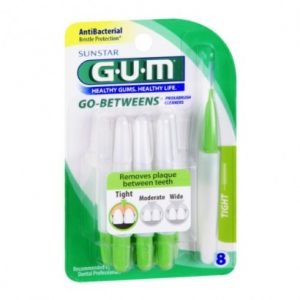
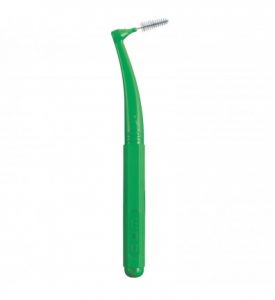
https://www.walgreens.com/store/c/g-u-m-proxabrush-go-betweens-cleaners-tight/ID=prod6270077-product
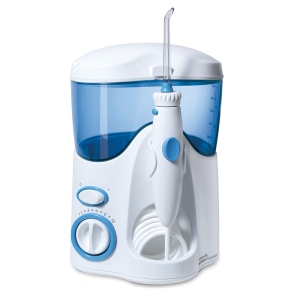
https://www.bedbathandbeyond.com/store/product/waterpik-reg-waterflosser-platinum-dental-electric-water-jet/1016883581
If You Experience Dry Mouth:
- Make sure you are drinking the recommended eight eight-ounces glasses of water per day.
- Sucking on ice throughout the day will keep your mouth lubricated. This is especially helpful to do just before and during chemotherapy infusions as the ice helps to limit how much of the chemical agents reach the blood vessels in the mouth, preventing sores. My tip is to suck on a popsicle or make flavored ice cubes. It just makes the process more yummy and enjoyable.
- Mouth rinses that are formulated to help with dry mouth and oral thrush make a world of difference. The Oral Cancer Foundation recommends Biotene, an alcohol-free rinse formulated with ingredients that lubricates the mouth for hours and helps balance the PH of the mouth. Periosciences is another good one using antioxidants and polyphenol to prevent cottonmouth. Before using, make sure to discuss with both your dentist and oncologist.
If you Experience Mouth Sores:
Dealing with canker-like sores is no joke. The first line of defense is a warm saltwater rinse. Saline helps disinfect aphthous ulcers and minimize inflammation. Here’s how to whip it up from stuff in your kitchen:
- Mix a teaspoon or two of salt (or baking soda) with a glass of warm water.
- Hold the mixture in your mouth and swish around from side-to-side.
- After three minutes, spit it out. Do not swallow, as it can make you dehydrated.
- Repeat after meals and before bed
I hope this helps! If you have any oral care fixes that worked for you, I’d love hear all about them!
XO
Cait
… Good news! There are more tips and tricks like the ones listed above in my book Pretty Sick: The Beauty Guide for Women with Cancer. Go visit and (like!) the Pretty Sick Book FB page! https://www.facebook.com/prettysickbook/?ref=aymt_homepage_panel
Pretty Sick is out September 19th, but you can order your copy now! Just click below on the retailer of your choice!
Amazon
Barnes & Noble
IndieBound
iBooks
Blog

Hair defines who we are. The cut speaks to our personality. The texture hints at our ethnic background. The color, when natural, can point to our age. Hair is also the ultimate accessory, allowing us to accentuate features, minimize flaws and transform into anyone we want to be. As my dear friend and celebrity hair stylist, Ted Gibson, says, “Hair changes everything.”
So, it shouldn’t come as any surprise that one of the first questions oncologists hear from patients after being diagnosed is, “Will I lose my hair?” I can relate, as it was the first questions I asked. The thought of losing my long brown wavy locks was overwhelming, scary and sad. Who would I be without my hair?
For many women, maintaining their mane during cancer treatment is a priority. For some, it’s about privacy in the workplace. For other’s it’s about having sense of control. For other’s it’s about protecting their children from a horrible truth. Fortunately, many patients who wish to keep their hair can, thanks to cold cap therapy.
While cold cap therapy is getting more popular by the day, there is still a lot of mystery and misinformation surrounding this treatment. For example, I assumed a patient wore a cap only during each chemo treatment. But, alas, I was wrong. It was only after researching and interviewing patients about the therapy that I realized how time-consuming and exacting it is.
If you are considering doing cold cap therapy, below is a quick Q + A that provides a basic breakdown of what you’ll need to know going in:
What is Cold Cap Therapy?
Cold Cap Therapy is a hair-saving treatment that uses snug, gel-filled hats, chilled to –15 to –45 degrees Fahrenheit, to help constrict the blood vessels, limiting the amount of chemotherapy that reaches the scalp. It is believed that the cold temps help reduce the metabolic activity of the follicular cells, reducing the effectiveness of the chemo on the hair allowing it to remain in place.
How Does Cold Cap Therapy Work?
The caps, which vary in design from company to company, resemble a combination of an ice pack and a swim cap. In order to maintain a consistent, cold temperature, four caps are stored in portable medical coolers over dry ice and patients are required to rotate caps every twenty to thirty minutes.




(Photos courtesy of DigniCap)
How Long Does it Take?
Cold capping is a huge time commitment. One patient I interviewed for my book Pretty Sick: The Beauty Guide for Women With Cancer told me there were days when she had to wear her cap for up to 13 hours! The reason why is that the caps need to be worn for up to an hour prior to chemotherapy, during the chemo infusion (which can last up to six hours), and then for four plus hours post-infusion. It’s a real commitment.
Is Cold Cap Therapy Painful?
That depends on your tolerance to cold temperatures. Some patients/survivors I talked to told me they would get bad freezer burn headaches that lasted throughout the treatment and that the caps left ice chips in their hair. The treatment also makes the entire body cold, so patients are advised to keep warm by wearing heavy sweaters, extra layers of socks and by wrapping themselves in an electric blanket. One great tip I learned was to apply Dr. Scholl’s moleskin or panty liners on the forehead and around the ears to prevent freezer burn on the skin.
What Is the Cost?
Patients can hire trained “cappers” whose will tote the coolers and ensure rotation and application of the caps is done properly and efficiently. But this comes at a price. Typically, cold cap rental costs roughly $600 per day. “Cappers” cost an additional $350 to $750 daily. Most insurance companies DO NOT cover the cost of this therapy. In 2015, a cold cap system, DigniCap, was cleared by the FDA, so there is hope that in the future insurance companies will pay for or offer partial reimbursement but for now it’s an out-of-pocket expense.
What Companies Offer Cold Cap Therapy?
There are four companies in the United States. I have listed their names and websites below:
DigniCap
https://dignicap.com/
Penguin Cold Caps
https://penguincoldcaps.com/us/
Chemo Cold Caps
http://chemocoldcaps.com/
Arctic Cold Caps
https://arcticcoldcaps.com/
Got any questions about cold cap therapy or any other cancer-related beauty question? I’d love to hear from you!
XO
Cait
…Hello again! If you got all the way down here, then I’m assuming you liked what you read. Good news! There’s more where that came from – including snippets of Pretty Sick: The Beauty Guide for Women with Cancer and news relevant to us Cancer Cuties. Go visit and (like!) the Pretty Sick Book FB page! https://www.facebook.com/prettysickbook/?ref=aymt_homepage_panel
Pretty Sick is out September 19th, but you can order your copy now! Just click below on the retailer of your choice!
Amazon
Barnes & Noble
IndieBound
iBooks
Blog

Nobody plans for a life crisis. It arrives without warning, leaving your world in a state of chaos and pain. All the plans you had get put on a shelf. This is cancer in a nutshell.
After my diagnosis, I didn’t think things could get worse. That was until I realized that I might survive cancer but my relationship of 9 years wasn’t going to. Apparently, things can, and often do, get worse.
I won’t bore you with the details. Honestly, our relationship was never the smoothest sailing ship. But when we finally broke up, I felt a level of pain and betrayal that far exceeded those inflicted by my cancer-stricken body. Battling cancer is a bitch. But it’s harder, scarier and sadder when you lose a relationship in the process. Just when I needed an unwavering supporter, someone to remind me how sassy and sexy I used to be, and would be again, that person was no longer there. I was on Survivor Island alone.
A health crisis is all-absorbing. In caring for our physical well-being, we forget to care for our relationships. We don’t have an interest in sex. We take our irritable moods out on those around us. Worry keeps us up at night and on edge. Conversely, even the most loving and supportive partners/spouses crack under the pressure of being a caretaker. The bad guys, well, they just show their true colors when the going gets tough.
But here’s the thing: there are some journeys that are meant for you alone. Whatever divine presence you believe in, it’s their way of taking you outside of your comfort zone and positioning you for greater things. It sucks that it takes hardship for humans to grow spiritually and emotionally – but such is the case. We don’t grow when we’re riding the wave. It is only when we are forced to dig deep to find our strength and courage that we make the changes that are truly necessary.
The good news is that the universe rewards you for such bravery. When my guy left, I was still in the middle of reconstruction. I had two scarred breast mounds and no nipples. Needless to say, my self-esteem and femininity were in tatters. But I turned inward and for the first time, in a long time, focused on just myself. Something that seemed so selfish before became essential for my emotional survival. I used each day to better my health, pretty up my apartment and beef up my resume.
Fast-forward three years and I am happy to say that my life is like a reversal of fortunes. I am engaged to a wonderful man (a man I never would have met had I not been on this journey alone), I have my first book coming out (a project that allowed me to rethink ‘loneliness’ and use it to elevate my talent and career) and I am healthy, happy and grateful.

If you are facing a similar situation to the one that I experienced – a life-changing diagnosis compounded by a heart-breaking divorce/breakup – then I have some words of advice to share. Here are my top 6 tips to healing with a broken heart:
- Focus on You
The time has come for you to focus on your needs. Whatever you think you need to do to find happiness and contentment, do it and do it often. I ate what I wanted. I binge-watched bad TV. And I started saying ‘no’ to things I didn’t want to do and people that didn’t improve my quality of life. It’s time to find your happy.
- Set Goals
Transformation doesn’t happen by itself. It’s imperative to visualize the goals you want to achieve and then start working toward them. Don’t bite off more than you can chew or expect overnight success. That will set you up for failure and disappointment. Instead, do one or two little things each day that puts you closer to your dreams. And every night before bed remind yourself of those achievements – because that’s exactly what they are.
- Reward Yourself
Did you shed the 5 lbs you wanted to lose? Did you redo your resume? Did you attend the theatre by yourself (and actually enjoy it)? When you take little brave steps, you make huge strides in transforming into the person you want to be. That, in my opinion, deserves reward. Buy the shoes. Go out to dinner. Treat yourself to a massage. (And don’t feel bad about it!) You earned it!
- Remember your Value
There will always be haters. Its just part of life. But it doesn’t mean you need to hang out with them! An important part of this journey is to take a step back and re-evaluate who you are giving your time and attention to. If someone doesn’t make you feel happy, empowered or wiser, then it’s time to leave them in the rear-view. You teach people how they should treat you. Set the standard.
- Call on your Girl Gang
When you start to feel sad and lonely, call one of your girlfriends. They will remind you how friggin’ fabulous you are (and will probably buy you a bottle of wine to boot)! How can things be really that bad with a best gal by your side? You may have lost a lover, but you still have lots of love in your life. Perspective is key to appreciating every relationship that is rewarding, positive and supportive.
- Give yourself a Break
No, you’re not going to get it right all of the time. Probably not even half the time. But who cares? Just consider the fact that there are 10 trillion planetary systems (10 TRILLION!!!!) in the known universe. Earth is just a fleck of dust in that mix. Anything you’re stressing about doesn’t matter in the grand scheme of things. Don’t beat yourself up. Give yourself a break. Enjoy your life.
XO,
Cait
…Hello again! If you got all the way down here, then I’m assuming you liked what you read. Good news! There’s more where that came from – including snippets of Pretty Sick: The Beauty Guide for Women with Cancer and news relevant to us Cancer Cuties. Go visit and (like!) the Pretty Sick Book FB page! https://www.facebook.com/prettysickbook/?ref=aymt_homepage_panel
Pretty Sick is out September 19th, but you can order your copy now! Just click below on the retailer of your choice!
Amazon
Barnes & Noble
IndieBound
iBooks
Blog

When writing my book, Pretty Sick: The Beauty Guide for Women with Cancer, I was struck by one thing I heard from almost every oncologist I interviewed – that the most common question patients asked after learning they would need chemotherapy was, “Will I lose my hair?”
There is no question that hair defines who we are. It not only helps showcase our looks but it helps chronicle the milestones of our lives. Just take a look at your prom picture and you’ll know exactly what I mean. It’s also a built-in security blanket. A certain cut or color can project to the world what we want it to see us as. It’s transformative.
I remember the first time I cried after my diagnosis was when I learned that I would lose my hair. I sobbed uncontrollably. It wasn’t that I was so concerned about my looks. It was that losing my hair made me grasp the magnitude of my diagnosis.
Facing hair loss during treatment is sad and scary. But it’s important to remember one thing: hair loss is temporary. I don’t say that to sound trite but it’s imperative to find the silver linings when battling cancer. One way to do that is to find a wig that makes you feel fabulous again.
But here’s the thing: there is a lot of information out there about wigs and a lot of different wigs to choose from. I’m going share the most important things to consider when shopping for your wig.
- Try to go shopping for your wig while you still have hair, if possible. This will allow the stylist to see your natural hair and help you find a wig that mimics it the closest.
- Bring only one or two close friends or family with you. And make sure they are the ones who will tell you the truth. If you bring an entourage of friends, you stand the chance of leaving with a blonde stripper wig.
- Know your budget before you go shopping. Insurance will throw a few bucks in – so know what that number is ahead of time as it will help steer your wig choice. My insurance gave me a budget of $200. Some insurance companies offer coverage or an allotment for something called “durable goods,” that includes items like oxygen, hospital beds and, in some cases, even wigs. Check your insurance plan to see if yours does too! A friend of mine was able to get reimbursed for a $5000 real hair wig. It took a year to get that reimbursement – but she got it!
- Determine how you plan on using your wig and how often you plan on wearing it. If, for example, you are an on-air TV host, you’ll probably need a wig made with real hair. But if you plan on being home most of your recovery or wearing turbans and headscarves often, a synthetic wig will work just fine. Knowing how you plan to use it will help determine exactly what type of wig you need.
- Know the Pros and Cons of Real Hair vs. Synthetic wigs. Here is a quick break-down:
REAL HAIR WIGS
Pros:
- It can be styled
- The part can be switched
- It can be cut and colored
Cons:
- It requires major upkeep
- It can be difficult to style
- It gets hot and heavy
- It is expensive
SYNTHETIC HAIR WIGS
Pros:
- It is easy to maintain
- No more bad hair days
- It is affordable
Cons:
- It can’t be styled
- It doesn’t last
- Longer length styles can tangle (opt for shoulder length)
- Opt for easy. While real-hair wigs are stunning and generally higher quality there is something to be said for starting with a synthetic wig. Real wigs are a lot of work and when you are sick and have depleted energy – it’s the last thing you are going to want to content with. Plus, there are some really gorgeous synthetic wigs that are also really affordable, so you’ll be able to get a few and have some fun. If you want to keep your life simple, synthetic is the way to go.
Good luck wig shopping!
XO
Caitlin
…Hello again! If you got all the way down here, then I’m assuming you liked what you read. Good news! There’s more where that came from – including snippets of Pretty Sick: The Beauty Guide for Women with Cancer and news relevant to us Cancer Cuties. Go visit and (like!) the Pretty Sick Book FB page!
Pretty Sick is out September 19th, but you can order your copy now! Just click below on the retailer of your choice!
Amazon
Barnes & Noble
IndieBound
iBooks
Blog
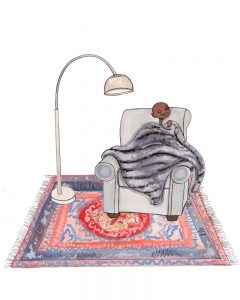
There is no question that having surgery is overwhelming and scary situation. There is so much to take care of leading up to the big day that it can be all consuming. Before my surgery, I had a long “to do” list: getting insurance approvals; putting in my time-off forms; paying the bills; and scheduling the dog sitter – just to name a few things. It was a stressful time.
When it was time to leave the hospital, I realized that I had been so busy preparing for surgery that I didn’t even think what came after: the recovery. I was woefully unprepared. I want to save you from making the same mistake. Trust when I say that I don’t want to add to your ‘to do’ list but there are some key essentials you should have/do prior to surgery to ensure a cozy and comfortable recovery. They are:
Get Key Clothing Items:
It was only after my mastectomy when I was still in the hospital that the nurses told me I would need some button down shirts in order to change my bandages. It would have been helpful to have this Intel prior to surgery! The only button ups I owned were starchy oxfords for work. My neighbor Victoria gave me a few of her old shirts but if she hadn’t come to my rescue I’m not sure what I would have worn. My suggestion is to consider where your incisions are and make sure you have a few items that are easy to put on/take off and won’t rub the surgical site when being worn. Stick with breathable, easy-to-clean fabrics like modal, or cotton/acrylic blends. Here are the essentials:
- Pajamas: Get at least two pairs of pajamas that button up the front. I love PJ sets but if you’ve had a flap reconstruction, sleep shirts (like the one below) make it easy to access the chest, stomach and buttocks. Opt for dark colors so that stains aren’t obvious.
https://www.victoriassecret.com/sleepwear/sleepshirts-and-nighties/supersoft-sleepshirt-body-by-victoria?ProductID=338170&CatalogueType=OLS
- Robe: If you have post-operative drains, there is a robe that has interior pockets that hold them in place without pulling on the incision. It’s soft and can be worn after your recovery as well. Trust me when I say it’s a game-changer.
https://thebrobe.com/products/recovery-brobe
- Hoodies: Contrary to popular belief, not all hoodies are created equal. I love the ones from Alternative Apparel because they zip up the front, are super soft and sustainable. (I am wearing this camo one as I write this post!) On days you feel crappy, this hoodie will keep you cozy.
http://www.alternativeapparel.com/adrian-printed-eco-fleece-zip-hoodie-09573fb#183=1990
- Tank Tops: Having a few tank tops with shelf bras are ideal because they are light, easy to layer and provide support and coverage. My all-time favorite brand is Tender Tanks, which were created/designed by breast cancer survivor, Carol Largent. Tender Tanks come with handy Velcro straps so they are easy to adjust throughout the various stages of reconstruction and recovery.
http://www.tendertanks.com/
Stock up on Supplies:
At some point after you get home, you will need to change your bandages. If you have drains, you will want to clean up around them until you can take a real shower. Keeping your incisions clean has a major impact on how they heal and how good or bad the scarring will be. So, make sure you have the following items at home before you head to the hospital.
- Gauze
- Neosporin
- Alcohol
- Hydrogen peroxide
- Medical tape
- Scissors
- Cotton Rounds
- Band-Aids
Pack the Pantry:
Grocery shopping after surgery is a no-go. Standing for an extended period of time and lugging heavy bags can deplete your energy and cause incisions to tear. Before surgery day, check with your doctor to see if you will have any food restrictions, and then make your grocery list. If you don’t have time to go food shopping before surgery or will be in the hospital for more than 3 days, give the list to a friend or relative with instructions to do the shopping the day before you arrive home. Make sure to have a few yummy snacks in the mix. (Sometimes when you lose your appetite, you need something super scrumptious to help sustain your energy). I got a few boxes of frozen fruit pops, as they were easy to eat, yummy and helped soothe the mouth sores I had gotten from chemo.
Schedule a Blowout:
You won’t be able to shower for a few days – maybe even a week! – After you get home from surgery. So it’s only a matter of time before you start to feel (and smell) gnarly. Most doctors will suggest taking a sponge bath to freshen up so make sure you have a few clean hand towels ready. (Skip actual sponges as they can harbor bacteria.) If you have hair, that will be another matter. Hoda Kotb gave me great post-surgery tips (you can read more of them in my book) including her advice to schedule a wash-n-blow at your local hair salon. There is nothing that feels a good as cleaning your hair for the first time after surgery.
Hope this helps!
XO
Cait
P.S. Have any essentials to add to this list? Email and let me know. I’d love to hear from you!
Blog

The Fourth of July has always been one of my favorite holidays. There are the obvious reasons: celebrating with friends and family in the warm summer air; burgers and dogs hot off the grill; sweet buttered corn on the cob; excited children swirling sparklers in the dark; and the booming fireworks that remind me of the battles fought years ago so that I could live free today. It makes me feel truly blessed and grateful to be American.
As the night sky lit up with exploding colors, I started to think about the meaning of ‘Independence.’ This year, that word takes on a whole new meaning as the vote on the GOP Healthcare bill looms days away. Very early on in my life, I had to be independent. From the time I graduated from high school, I supported myself. Minus financial aid, I put myself through college, paid my own rent and bought my own clothes and food. I was always a hustler and never took a handout. This is the case to this day. Everything I have, I have because I worked for it. I am proud of this fact.
But I would not be able to be so independent if I didn’t have health coverage. When I had spinal fusion back surgery in 2011, the first bill I received from the hospital was $170,000. At the time, it was more than double my editor’s salary. I remember calling my father hysterical. Thank goodness my insurance covered most of that bill. A year later, when I was diagnosed with breast cancer, my medical coverage allowed me to go to the best surgeons and hospitals in New York. Because of this, I was able to focus on my recovery, continue working during treatment, and maintain a relatively ‘normal’ life. Two years later, while in the middle of breast cancer reconstruction and freelancing to earn a living, my surgeries were covered by the Affordable Care Act (ObamaCare). Today, I am thriving because of the insurance I received. Good healthcare coverage was key to all of it.
But the GOP Healthcare bill will change all of this.
Under this new bill, my history of back surgery and cancer put me in the “pre-existing conditions” category. While the bill does preserve the pre-existing condition protections that exist in the ACA – insurance companies would have to offer a plan to people with medical problems – it has major pit falls. For example: If a state doesn’t include certain treatments or medicines in their benefits, then insurance companies can elect not to pay. Even if it means life or death to a patient. If the past is any indication, they won’t pay because your life isn’t more important than their profits.
Making matters more urgent and stressful for me, is that I am recently unemployed and find myself worrying about having health coverage. I am also recently engaged and I’ve had people suggest I elope so I can get on my fiancé’s insurance. What is this, 1950? I have to get married to ensure I have healthcare? That’s not what I want my wedding to be about. And I don’t want to be dependent on anybody. I want to be independent – the way I’ve been my entire life. Isn’t that what we should be striving for as a society? To empower people to take care of themselves – and when they get too sick they still have the resources to do so? That is what real independence is all about. It’s one of the things I love so much about America: that we care for each other and band together when in moments of crisis. That is what made America great in the first place.
As this majestic holiday comes to a close, I’m hoping that our elected officials also took a moment this July 4th to ponder the meaning of words like “freedom” and “independence.” I am also hoping they consider how the GOP healthcare bill will impact those basic American principles when they vote. My life, and many others, depend on it.
Xo,
Cait
PS: It isn’t too late to act! Making a call to a Senator – not just those in your state – can make all the difference. Below is the link to all the Senate Contact Directory. Let your voice and opinion be heard!
https://www.senate.gov/senators/contact/senators_cfm.cfm?State=DE
Blog
I love the heat. I think I’m in the minority on this one. Most of my friends and family prefer the crisp air of autumn. I like the fall (cuz it’s my birrrrfday!) but I really love the heat. What I don’t love is that my cancer medicine, Tamoxifen, makes me sweat through the easiest chores and it obviously gets worst in the hot weather. For example, when blow-drying my hair I get so sweaty that the hair that I just dried gets soaking wet all over again. Even my cheeks, chest and arms glisten with perspiration. It’s annoying – to say the least. And while I think I have it bad, I think about my fellow Cancer Cuties who have lost their eyebrows and are trying to keep their painted-on ones in place. The struggle is real.
For those of you who are experiencing this first-hand for the first time, I have some good news – there is an easy fix. Selecting the right brow products – specifically those that are made with a wax base – will keep your arches in place no matter what the weather. As my dear friend and makeup artist Ramy Gafni says, “You don’t want your brows coming off at brunch!” So true. The goal is to look hot – not like a hot mess.
There are three wax-based brow products that I think are the best especially for patients/survivors who don’t have actual hair to layer over. My favorites are:
Ramy Miracle Brow: This comes with two brow colors and a precision brush. The beauty of this is that the wax formula stays locked in place while you can blend the shades to customize your color. $28, ramy.com or Amazon.com
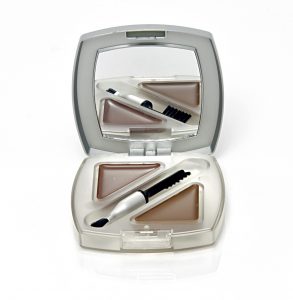
Benefit Cosmetics Brow Zings Eyebrow Shaping Kit: Legendary newswoman and fellow cancer survivor, Joan Lunden, told me she loved using this kit while she was in treatment. “It comes with a pigmented wax and powder and two tiny brushes. You dip the little angled brush into the wax to create the shape, and then you use the other brush to apply the powder to set it in place. I like it because it really lasts.” Bonus: It comes in 6 shades. $32, benefitcosmetics.com

Nudestix Eyebrow Stylus Pencil & Gel: I love this dual-ended product because of the tri-angled pencil tip. It really allows you to mimic the look of individual eyebrow hairs for a really precise, feathery look. Both the wax formula and clear gel are waterproof (key) and vegan. You may not need the gel when you don’t have any hair of your own, but once they start growing back, you’ll love how the stronghold formula makes your brows last all day! $24, nudestix.com

Two key tips to follow when creating eyebrows from scratch:
- When you have no eyebrow hair, you need to use a darker shade then your normal hair color to have it show up against bare skin. This seems counter-intuitive because it is the opposite of what you do when you have eyebrow hair. But trust me on this. Going 1-2 shades darker does the trick
- If you are using a brow pencil or kit that doesn’t come with powder, use a little translucent powder to set it in place. This does a few things: it softens the color; nixes the waxy shine; and forms a seal over the wax so it adheres longer.
If you have any makeup tricks, product recommendations or questions – share them with me! I want to hear from you! Good luck!!!
XO
Cait
Blog
One of the things I mentioned in my first blog entry was that I have a book coming out on September 19th. Holla!!!! The book is titled, Pretty Sick: The Beauty Guide for Women with Cancer. I’m very excited about it, as it’s been 3 years in the works.
Here it is (!!!!!!!)
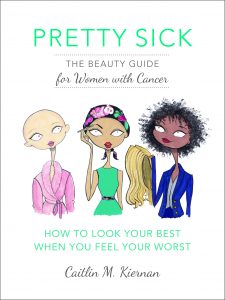
For those of you who don’t know me, let me quickly explain what led me to write the book in the first place. When I was diagnosed with breast cancer at the age of 41, I was working as a beauty director for a magazine. Like many of my fellow cancer patients, I became glued to the web researching what was about to happen to my body. Naturally, I was very nervous about all the side effects because I had to continue working my full-time job to pay the bills. But no matter how much I searched, there wasn’t one site, one book, one resource that had all the answers I needed.
Luckily for me, as a beauty editor, I spent most of my days interviewing the top experts in the field – hair stylists, makeup artists, dermatologists, manicurists, etc. You get the gist. So, after I was diagnosed, I turned to these pros to get all the Intel I needed to keep me looking and feeling my best during surgery and treatment. While I was very concerned about getting healthy, the reality is that I also needed to look presentable in order to do my job. The last thing I wanted to deal with was the “Are you okay?” questions. They just made me feel worse.
The thing that’s so crazy about cancer is that it isn’t the disease that makes you look sick. It’s the treatment that does. Case in point: a bald head. This big telltale sign isn’t caused by the rogue cells in your body, it’s caused by the chemo that’s used to kill them.
I know I was lucky to have amazing pros giving me useful tips and tricks to help me through my illness. I also know there are a lot of women out there going through what I went through with less or no resources to help them. This makes me very sad because, in some cases, there are little things that can make a huge difference offsetting or lessening the harsh side effects of treatment. That’s why I decided to use my skills as a writer and put all the information I was blessed to receive in one little book. Pretty Sick is my way of paying it forward to help empower other women with cancer.
It is my wish that if you come across this blog or the book’s Facebook page that you share it with someone who is fighting the battle and could use a little help. As I always say: when you look good, you feel better. I would also love to hear from you. If there are any topics or tips you’d like me to share or if you have anything that could help other patients and survivors – email me! My email is [email protected].
Until next time,
XO
Cait



























